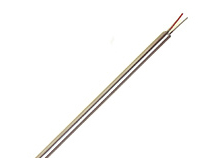

Resistance thermometers, also called resistance temperature detectors or resistive thermal devices (RTDs), are temperature sensors that exploit the predictable change in electrical resistance of some materials with changing temperature. As they are almost invariably made of platinum, they are often called platinum resistance thermometers (PRTs). They are slowly replacing the use of thermocouples in many industrial applications below 600°C, due to higher accuracy and repeatability.
There are many categories: carbon resistors, thin-film, and wire-wound types are the most widely used.
Function-
Resistance thermometers are constructed in a number of forms and offer greater stability, accuracy and repeatability in some cases than thermocouples. While thermocouples use the Seebeck effect to generate a voltage, resistance thermometers use electrical resistance and require a power source to operate. The resistance ideally varies linearly with temperature. Resistance thermometers are usually made using platinum, because of its linear resistance-temperature relationship and its chemical inertness. The platinum detecting wire needs to be kept free of contamination to remain stable. A platinum wire or film is supported on a former in such a way that it gets minimal differential expansion or other strains from its former, yet is reasonably resistant to vibration. RTD assemblies made from iron or copper are also used in some applications. Commercial platinum grades are produced which exhibit a change of resistance of 0.00385 ohms/°C (European Fundamental Interval) The sensor is usually made to have a resistance of 100 O at 0°C. This is defined in BS EN 60751:1996 (taken from IEC 60751:1995) . The American Fundamental Interval is 0.00392 O°C, based on using a purer grade of platinum than the European standard. The American standard is from the Scientific Apparatus Manufacturers Association (SAMA), who are no longer in this standards field. As a result the "American standard" is hardly the standard even in the US. Measurement of resistance requires a small current to be passed through the device under test. This can cause resistive heating, causing significant loss of accuracy if manufacturers' limits are not respected, or the design does not properly consider the heat path. Mechanical strain on the resistance thermometer can also cause inaccuracy. Lead wire resistance can also be a factor; adopting three- and four-wire, instead of two-wire, connections can eliminate connection lead resistance effects from measurements (see below); three-wire connection is sufficient for most purposes and almost universal industrial practice. Four-wire connections are used for the most precise applications.